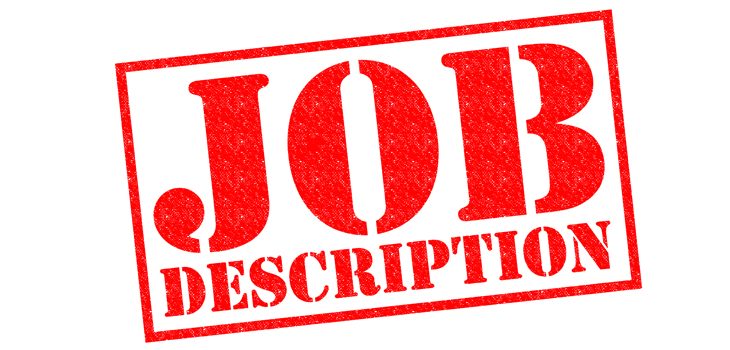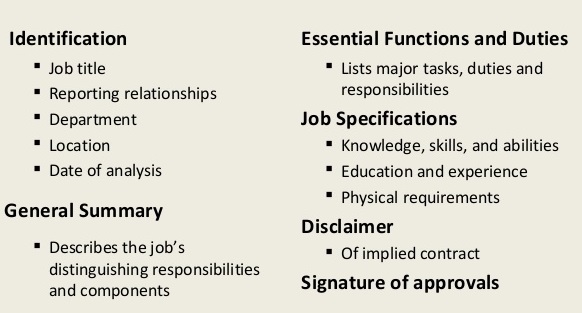Not every manager bothers with job descriptions. So why should your company use them?
However, writing job descriptions is a key step in planning your staffing programs. They are the very foundation for many important processes. Some of those relevant processes may be job postings, recruitment, selection, setting expectations, compensation, training and performance management. What should job descriptions include?
Job descriptions should offer a brief overview of the role, how it relates to your company values, vision, and mission, a list of key responsibilities, requirements and qualifications.
Every minute spent developing job descriptions has many advantages. Lets consider just a few of them:
- Job descriptions are a valuable tool to make sure your staff duties align with your company vision
- They help developing recruiting strategies that clearly outline to applicants their role and responsibilities. This in turn, enables you to make better hiring decisions.
- They effectively are the foundation for the development of interview questions.
- They can be used to determine areas in need of training and development when expectations or requirements are not being met.
- They provide a basis on which to develop compensation plans that ensure jobs are being compensated in ways that reflect their levels of responsibility and qualification in the organization.
- They help to communicate expectations, so job descriptions also serve as a basis for performance management. For the employee, they help understand the responsibilities and duties that are required and expected of them.
How does a typical job description look like? 
They usually have the following areas or sections:
- A high-level summary of the key duties
- Identification of the values that should be demonstrated by all staff
- A detailed list of the responsibilities
- A description of the experience, knowledge, skills and abilities required
- A list of any special working conditions or minimum physical requirements – e.g. must be able to lift 15 kilos
Each task, function or responsibility should start with an action verb that describes the activity in a way that clearly indicates what is expected. You would want to use action verbs such as:
controls
coordinates
develops
evaluates
inputs
maintains
operates
schedules
supervises
trains
other action verbs
By having a list of up-to-date job descriptions for all your positions, you will have the foundation to develop many key HR (human resources) programs to drive the success of your business.
Job Title
Department
Location
Reports to
General Purpose
This is a summary of the overall purpose of the job. Clearly stated in a couple of sentences.
Key Tasks and Responsibilities
These refer to the activities, functions and areas of accountability for the job are clearly defined here. Effective job descriptions start each key task with a verb that describes what the employee has to do. Examples include action vers like the ones we discussed earlier. Just to review again some action verbs, read them out loud and make a full sentences with each one of them: develop, meet, organize, plan, arrange, supervise, communicate, review, prepare, manage, monitor, write, handle, evaluate, maintain, analyze and implement.
Education and Training
State the necessary level of education and qualifications and training required to perform the job.For example Bachelors Degree, diploma, examinations passed, registrations and accreditation.
Knowledge and Experience
Specific experience required. Specific knowledge required.For example knowledge and experience of software applications, equipment, job methods and tools, technical processes, accounting principals, legislation and standards.
Core Competencies
These are the skills and abilities required to successfully perform the key tasks. Competency examples include communication skills, planning and organizing ability, problem analysis, problem solving, adaptability, the ability to delegate, stress tolerance, initiative, negotiation skills, persuasiveness and attention to detail.
Working Conditions
State any working conditions that the employee needs to be aware of such as working environment, hours of work and any special conditions such as high noise levels, shifts, travel and overtime. Salary and benefits can also be included here.
Ok, you’ve got the hang of it. But how about we review an example of a draft for an actual job for a law admin role?

LAW CLERK JOB DESCRIPTION
Law Clerk Job Responsibilities:
A law clerk supports attorneys by assembling and organizing information for legal documents; researching law; assembling case materials; writing reports and memoranda.
Law Clerk Job Duties:
- Prepares legal drafts by assembling and organizing information for legal forms and documents, including complaints, declarations, discovery requests, responses, and other pleadings.
- Researches law by studying laws, statutes, constitutions, regulations, court opinions, including precedents and reasoning, and trends using standard print texts and computers; preparing legal memoranda.
- Assembles case materials by collecting, organizing, and summarizing information, documents, reports, and evidence.
- Prepares for trial by preparing trial briefs, exhibits, subpoenas, evidence, and motions.
- Maintains calendar by entering and updating requirements, court dates, and meetings.
- Protects law firm’s reputation by keeping client information confidential.
- Updates job knowledge by participating in continuing educational opportunities; reading legal publications; maintaining personal networks.
- Enhances firm’s reputation by accepting ownership for accomplishing new and different requests; exploring opportunities to add value to job accomplishments. Skills/Qualifications: Client Confidentiality, Client Contact Skills, Legal Administration Skills, Legal Compliance, Litigation, Administrative Writing Skills, Documentation Skills, Word Processing , Scheduling, Verbal Communication, Client Relationships
Law Clerk Skills and Qualifications:
Client Confidentiality, Client Contact Skills, Legal Administration Skills, Legal Compliance, Litigation, Administrative Writing Skills, Documentation Skills, Word Processing , Scheduling, Verbal Communication, Client Relationships
Do you feel quite ready to create JDs in English? Let’s create one just for fun, shall we?


